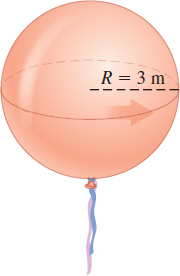EXAMPLE 2Solving a Related Rate Problem
A spherical balloon is inflated at the rate of 10 m3/min. Find the rate at which the surface area of the balloon is increasing when the radius of the sphere is 3m.
Solution We follow the steps for solving a related rate problem.
Step 1 Figure 3 shows a sketch of the balloon with its radius labeled.
Step 2 Identify the variables of the problem: t=the time (in minutes) measured from the moment the balloon beginsinflatingR=the radius (in meters) of the balloon at time tV=the volume (in meters cubed) of the balloon at time tS=the surface area (in meters squared) of the balloon at time t
Identify the rates of change: dRdt=the rate of change of the radius of the balloon (in meters per minute)dVdt=the rate of change of the volume of the balloon (in meters cubed perminute)dSdt=the rate of change of the surface area of the balloon (in meters squaredper minute)
We are given dVdt=10 m3/min, and we seek dSdt when R=3m.
257
Geometry formulas are discussed in Appendix A.2, p. A-15.
Step 3 Since both the volume V of the balloon (a sphere) and its surface area S can be expressed in terms of the radius R, we use two equations to relate the variables. V=43πR3 and S=4πR2 where V,S, and R are functions of t
Step 4 Differentiate both sides of the equations with respect to time t. dVdt=4πR2dRdt and dSdt=8πRdRdt
Combine the equations by solving for dRdt in the equation on the left and substituting the result into the equation for dSdt on the right. Then dSdt=8πR(dVdt4πR2)=2RdVdt
Step 5 Substitute R=3m and dVdt=10m3/min. dSdt=(23)(10)≈6.667
When the radius of the balloon is 3m, its surface area is increasing at the rate of about 6.667m2/min.
